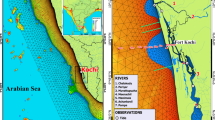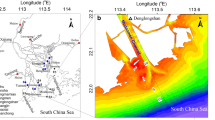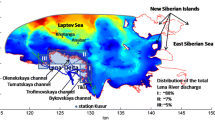Abstract
The time-dependent plume front positioning with respect to different tidal phases and its dynamics coupled with seasonal river efflux on the shelf off Kochi, southwest coast of India, was investigated using Finite Volume Community Ocean Model (FVCOM). This region is linked with a monsoonal estuary, characterised by a mixed semidiurnal tide (1 m) and exhibited features of small and large-scale plumes. The interaction between river efflux and tidal phases modulates plume fronts on the shelf, where the density gradients are fortified or weakened by mixing dynamics. Even though the heavy river efflux in the summer monsoon imparts significant momentum on the shelf, the range of frontal fluctuation was curtailed to 2 km by strong monsoon currents. During the transient phase of the season (fall inter-monsoon), the tidal forcings on plume positioning overwhelm the shelf currents, such that the plume front fluctuates between 5 and 17 km from the inlet (range increasing to ~12 km). During low tides, the region near the inlets was almost homogenised (Rd<1), while during high tides, the region became more stratified due to the transport of high saline coastal water towards the inlet and also by the decreasing kinetic energy (Richardson number, Rd>1). The location of frontal zones suitable for the propagation of internal waves (Froude number, F≤ 1) changes as a result of the competition between river efflux and tide-topography interaction. Strong stratified plume frontal regions with high Brunt Vaisala Frequency (N) could be active zones of internal wave generation when the flow decelerates from supercritical to subcritical during the summer monsoon. The release of accumulated potential energy during the transition from high tide to low tide generates the hydraulic jump. This disturbance in the Nmax zone together with F ≤ 1 condition (supercritical flow changed to subcritical flow) favours the generation and propagation of plume-induced internal waves on the shelf. Satellite imageries demonstrate such propagation of plume-generated internal waves on the shelf off Kochi.















Similar content being viewed by others
Data availability
The data that support the findings of the study are available from the corresponding author, Seena G., upon reasonable request. The data utilised for land water-interface and bathymetry (GEBCO) were available online at http://www.soest.hawaii.edu/wessel/gshhg/ and at https://download.gebco.net/, respectively. Model forcings can be obtained from ECMWF (https://apps.ecmwf.int/datasets/data/interim-full-daily/levtype=sfc/). The open boundary inputs were accessible from global Hycom model (http://tds.hycom.org/thredds/catalog.html). Model data will be available upon request to the corresponding author, and the in situ data used for model validation will be available upon request to CSIR-NIO data repository (www.nio.org).
References
Azeez A, Revichandran C, John S et al (2021) Sound speed variation in the coastal waters off Cochin and signature of subsurface maxima. Ocean Dyn 71:923–933
Chen C, Liu H, Beardsley RC (2003) An unstructured grid, finite-volume, three-dimensional, primitive equations ocean model: application to coastal ocean and estuaries. J Atmos Ocean Technol 20:159–186
da Silva JCB, Helfrich KR (2008) Synthetic Aperture Radar observations of resonantly generated internal solitary waves at Race Point Channel (Cape Cod). J Geophys Res Ocean 113
Dagg JM, Benner R, Lohrenz S, Lawrence D (2004) Transformation of dissolved and particulate materials on continental shelves influenced by large rivers: plume processes. Cont Shelf Res 24:833–858. https://doi.org/10.1016/j.csr.2004.02.003
Garvine RW (1995) A dynamical system for classifying buoyant coastal discharges. Cont Shelf Res 15:1585–1596
Garvine RW, Monk JD (1974) Frontal structure of a river plume. J Geophys Res 79:2251–2259
Groeskamp S, Nauw JJ, Maas LRM (2011) Observations of estuarine circulation and solitary internal waves in a highly energetic tidal channel. Ocean Dyn 61:1767–1782
Jay DA, Smith JD (1990) Residual circulation in shallow estuaries: 1. Highly stratified, narrow estuaries. J Geophys Res Ocean 95:711–731
Jineesh VK, Muraleedharan KR, John KL et al (2015) Mesoscale process-induced variation of the West India Coastal Current during the winter monsoon. Environ Monit Assess 187:1–13
Kilcher LF, Nash JD (2010) Structure and dynamics of the Columbia River tidal plume front. J Geophys Res Ocean:115
Martin GD, Muraleedharan KR, Vijay JG et al (2010) Formation of anoxia and denitrification in the bottom waters of a tropical estuary, southwest coast of India. Biogeosciences Discuss 7:1751–1782
Morgan CA, De Robertis A, Zabel RW (2005) Columbia River plume fronts. I. Hydrography, zooplankton distribution, and community composition. Mar Ecol Prog Ser 299:19–31
Nash J, Moum JN (2005) River plumes as a source of large-amplitude internal waves in the coastal ocean. Nature 437:400–403
Prasanna Kumar S, Narvekar J, Kumar A, et al (2004) Intrusion of the Bay of Bengal water into the Arabian Sea during winter monsoon and associated chemical and biological response. Geophys Res Lett 31
Revichandran C, Srinivas K, Muraleedharan KR et al (2012) Environmental set-up and tidal propagation in a tropical estuary with dual connection to the sea (SW Coast of India). Environ Earth Sci - Env EARTH SCI 66. https://doi.org/10.1007/s12665-011-1309-0
Seena G, Muraleedharan KR, Revichandran C et al (2019) Seasonal spreading and transport of buoyant plumes in the shelf off Kochi, South west coast of India-A modeling approach. Sci Rep 9:1–15
Smitha BR, Sanjeevan VN, Vimalkumar KG, Revichandran C (2008) On the upwelling off the southern tip and along the west coast of India. J Coast Res 95–102. https://doi.org/10.2112/06-0779.1
Spicer P, Cole KL, Huguenard K et al (2021) The effect of bottom-generated tidal mixing on tidally pulsed river plumes. J Phys Oceanogr 51:2223–2241
Vijith V, Sundar D, Shetye SR (2009) Time-dependence of salinity in monsoonal estuaries. Estuar Coast Shelf Sci 85:601–608
Wei Q, Yu Z, Wang B et al (2017) Offshore detachment of the Changjiang River plume and its ecological impacts in summer. J Oceanogr 73:277–294
Yankovsky AE, Chapman DC (1998) A simple theory for the fate of buoyant coastal discharges. Oceanogr Lit Rev 3:435
Acknowledgements
The first author is very thankful to DST. The authors are grateful to the Director, CSIR-NIO and SIC, NIO-RC Kochi, for fulfilling the studies. A special acknowledgement is given to the FVCOM development team members in The Marine Ecosystem Dynamics and Modeling Laboratory, UMASSD, for providing the FVCOM source code. We sincerely acknowledge Dr. Usha V. Parameswaran, a native English speaker and project scientist at CMLRE, Kochi, for proof editing of the manuscript. This is CSIR-NIO contribution no.
Funding
The Department of Science and Technology funded the study under the WOS-A scheme (GAP 2908).
Author information
Authors and Affiliations
Contributions
G.S. managed the funding, data analysis and writing of the manuscript; K.R.M. conceived the problem, field survey, analysis and interpretation of the data; C.R. oversaw the project and was involved in the discussion and draft preparation; K.R.M., S.A.A., G.S., J.S. and R.C.N., were involved in the modelling studies; G.S., S.A.A. and R.C.N. prepared the figures and model validation diagrams. All authors reviewed the manuscript.
Corresponding author
Ethics declarations
Ethics approval
This article does not contain any studies with human participants or animals performed by any of the authors.
Consent to participate
For this type of study, formal consent is not required.
Conflict of interest
The authors declare no competing interests.
Additional information
Responsible Editor: Eric Deleersnijder
Rights and permissions
About this article
Cite this article
Seena, G., Muraleedharan, K.R., Revichandran, C. et al. Time-dependent plume front positioning and its dynamics coupled with seasonal river efflux. Ocean Dynamics 72, 207–222 (2022). https://doi.org/10.1007/s10236-022-01499-8
Received:
Accepted:
Published:
Issue Date:
DOI: https://doi.org/10.1007/s10236-022-01499-8




